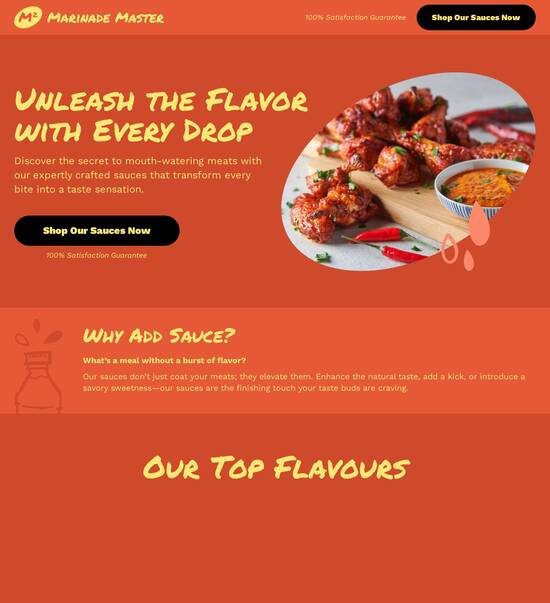
Pricing page template for real estate companies
Explore Similar TemplatesAbout template
Reach out to the right audience with pricing page template for real estate companies
Recommended templates

Easy to build without coding
With the intuitive drag-and-drop builder, anyone on your team can create high-converting pages without any knowledge of code or design. Make enhancements to your landing page with custom widgets using Javascript, HTML/CSS, or third-party scripts.

Multiple layouts for any industry and goal
Select from 500+ landing page layouts built to boost conversions across industry-specific scenarios. Customize them by adjusting fonts, adding images, and generating on-brand content with the AI assistant. Quickly scale with Instablocks® and Global Blocks that you can save, reuse, and update globally.

Loads fast and looks polished on any device
Every template is responsive, which means they present professionally on any device and load blazingly fast with our Thor Render Engine. You can also power them up with Google AMP technology to deliver an unparalleled mobile experience and drive higher conversions.

Robust analytics & experimentation
Get real-time updates and reporting across all your devices, showing the number of visitors, conversions, cost-per-visitor, and cost-per-lead. Launch AI-powered experiments, run A/B tests, and use heatmaps to analyze user behavior, then optimize your landing page to maximize conversions.







Easy to build without coding
With the intuitive drag-and-drop builder, anyone on your team can create high-converting pages without any knowledge of code or design. Make enhancements to your landing page with custom widgets using Javascript, HTML/CSS, or third-party scripts.
Multiple layouts for any industry and goal
Select from 500+ landing page layouts built to boost conversions across industry-specific scenarios. Customize them by adjusting fonts, adding images, and generating on-brand content with the AI assistant. Quickly scale with Instablocks® and Global Blocks that you can save, reuse, and update globally.
Loads fast and looks polished on any device
Every template is responsive, which means they present professionally on any device and load blazingly fast with our Thor Render Engine.
Robust analytics & experimentation
Get real-time updates and reporting across all your devices, showing the number of visitors, conversions, cost-per-visitor, and cost-per-lead. Launch AI-powered experiments, run A/B tests, and use heatmaps to analyze user behavior, then optimize your landing page to maximize conversions.
All the features you need to build lead-generating landing pages
Explore more featuresLearn how to build top-performing landing pages for any goal
FAQs
Leading the way in building high-performing landing pages





A comprehensive guide to optimizing landing pages with Instapage
Instapage offers an exceptional solution for marketers aiming to enhance their digital marketing strategies through powerful landing page optimization. With its diverse range of customizable templates, seamless integration options, and robust optimization tools, Instapage stands out as the preferred choice for various industries—including business services, tech, education, and more—seeking to maximize ROI from their campaigns.
Understanding the basics of landing pages
Landing pages act as dedicated web pages designed with specific goals in mind, creating pathways for conversion. They are critical in digital marketing, especially for driving lead generation, capturing user information, and promoting products or services. Marketers can leverage Instapage’s high-converting templates to ensure their landing pages are not only appealing but also effective in driving user action.
- Clarity of Purpose: Every landing page should have a clear and specific goal, whether it's to capture leads, promote a product, or encourage downloads.
- Engaging Design: A visually appealing design can significantly enhance user experience and increase conversion rates.
- Effective Call-to-Action: The call-to-action (CTA) should be clear and compelling, urging users to take the desired action.
Step 1: Choose the right template
Begin by selecting a template that aligns with your campaign goals. Instapage provides over 100 ready-to-use templates tailored for various industries. These templates can be easily modified to match your brand identity and messaging.
Step 2: Customize your landing page
Once you’ve chosen a template, customize it to fit your unique requirements. Utilize Instapage’s drag-and-drop builder to alter text, images, and layout effortlessly.
- Add Dynamic Text Replacement: Personalize your landing page using dynamic text that adapts to the ad your visitor clicked.
- Utilize Instablocks: Reuse sections across multiple pages to maintain design consistency and save time.
- Include Lead Generation Elements: Embed forms or contact fields directly on the page to capture visitor information.
Step 3: Optimize for performance
Monitoring and optimizing your landing page is crucial for maximizing conversions. Instapage provides advanced analytics and A/B testing tools, allowing you to see what works best for your audience.
- A/B Testing: Experiment with different layouts, copy, and CTAs to identify which combinations yield the highest conversions.
- Heatmaps: Analyze user behavior on your pages to understand where visitors are clicking and what content keeps them engaged.
- Performance Metrics: Use Instapage's analytics dashboard to track conversions, bounce rates, and traffic sources.
By following these steps, marketers can leverage Instapage to create high-performing landing pages that effectively convert potential customers, optimize workflow, and ultimately increase ROI.
Start maximizing your marketing efforts today with Instapage. Try our platform to create amazing landing pages that not only look great but drive incredible results.
The ultimate pricing page template for real estate companies
Understanding the importance of a well-crafted pricing page in real estate
A well-designed pricing page serves as a pivotal element in real estate marketing. It acts as the initial touchpoint for potential clients, presenting them with vital information about the services and properties on offer. A robust pricing page not only communicates value effectively but also clearly outlines what clients can expect in return for their investment. At its best, a pricing page should reflect the brand's identity while providing a straightforward understanding of its offerings.
Transparency in pricing is crucial in building trust and credibility in the real estate industry. Given the high stakes involved in property transactions, clients seek reassurance that they are making sound financial decisions. In this context, real estate companies must consider their specific needs, which often differ from those of other businesses. Unlike general service providers, real estate agents and brokers deal with varying property values, commission structures, and client expectations, all of which must be clearly conveyed through an effective pricing page.
Key features of a real estate pricing page template
When designing a pricing page template specifically for real estate companies, customization capabilities are paramount. A high-quality pricing table template should cater to a range of niche markets within the real estate sector, such as residential, commercial, luxury, or rental properties. Templates provided in PSD format allow for designers to create unique visual designs that align perfectly with the company's branding. This flexibility ensures that the pricing page doesn’t look generic but resonates with the target audience.
Additionally, ease of customization plays a vital role. With a user-friendly template, real estate companies can quickly adapt their pricing pages to reflect changes in services or property offerings. Whether it’s adjusting pricing tiers or adding new categories, these templates simplify the task while maintaining a professional appearance. The integration of intuitive design elements makes a significant difference in user engagement, ultimately driving conversions.
Responsive and mobile-friendly design
In today’s fast-paced environment, mobile optimization is no longer optional; it is essential for real estate buyers and sellers. Many individuals begin their property searches on mobile devices, making it imperative for pricing pages to be responsive and mobile-friendly. A responsive design adapts seamlessly to various screen sizes, ensuring that all pricing details are readily accessible, regardless of device type. This adaptability not only enhances the user experience but can also significantly increase the likelihood of converting visitors into leads.
Effective responsive design enhances usability by prioritizing key elements, such as pricing tables and call-to-action buttons. For example, dynamic pricing page designs might collapse additional information into expandable sections on mobile devices, making access simple without overwhelming the user. By prioritizing functionality and user experience, real estate companies can effectively keep potential clients engaged throughout their property search.
Pricing table components
A well-structured pricing table is fundamental to conveying information effectively. The core elements of a pricing table template include clear pricing columns and rows, which allow users to compare different service offerings at a glance. Descriptive labels should clearly outline what each service or property tier entails, guiding users through their decision-making process effortlessly. Highlighting features for each pricing tier adds depth, showcasing unique benefits to prospective clients.
Clear pricing structures that delineate various service levels.
Concise, descriptive labels that enhance understanding.
Highlighting key features that differentiate offerings.
The impact of a simple, clean layout cannot be underestimated. Research indicates that well-organized layouts significantly enhance the customer decision-making process. A clutter-free design, combined with strategic use of white space, guides users toward call-to-action areas. This thoughtful layout ultimately enables clients to make informed decisions with confidence.
Engaging user experience through interactive design
Utilizing buttons effectively is crucial for enhancing user engagement on pricing pages. Strategic placement of call-to-action buttons ensures they are prominently displayed, guiding visitors toward the next step in their journey. A/B testing various button designs can reveal which variations resonate best with users, helping to optimize conversion rates. For example, using contrasting colors and clear calls to action can draw attention and encourage clicks.
Employing captivating button designs that provoke action—such as 'Get a free quote' or 'Schedule a viewing'—works effectively. These buttons not only facilitate better navigation but also create tangible opportunities for engagement, increasing the likelihood of conversion.
Visual hierarchy in pricing page design
Visual hierarchy plays a critical role in informing how users interact with a pricing page. An effective layout uses techniques that guide users toward the information most pertinent to their needs. Implementing size variations, contrasting colors, and strategic placement of elements can draw focus to essential components, like pricing details and call-to-action buttons. For example, using larger fonts for pricing options can signal their importance and make them stand out.
Example templates can showcase effective use of color and typography to achieve this hierarchy. Using bold typographic elements for headings while employing softer tones for supporting information ensures that clients can quickly differentiate between primary and secondary details. This design principle enhances the overall experience, making it easier for users to digest critical information without feeling overwhelmed.
Best practices for effective pricing page creation
To create an effective pricing page, displaying comprehensive pricing information is crucial. This involves offering clear, concise, and comparative pricing models, ensuring that potential clients understand what they are paying for. It is essential to showcase what’s included at each price tier, which can help prospective customers ascertain the best fit for their needs. Transparency in pricing strategies fosters trust, a vital component in the real estate industry.
Use clear comparison tables to outline different tiers.
Highlight included features to add value.
Maintain transparency to build consumer trust.
Some successful real estate companies have effectively incorporated transparent pricing strategies. Their pricing pages explicitly list out all features included at each price point, allowing potential customers to assess the value of each option. This clarity can lead to better-informed decisions, ultimately driving higher conversion rates and increased customer satisfaction.
Incorporating testimonials and social proof
Customer testimonials and social proof play a pivotal role in enhancing credibility on pricing pages. The inclusion of real client feedback can significantly influence decision-making for prospective clients. Effective placement of testimonials on pricing pages ensures they are seen while not detracting from essential pricing information. Utilizing quotes and images of satisfied clients adds a personal touch and reinforces the trust factor.
Position testimonials near pricing options to reinforce value.
Use authentic quotes and client images for credibility.
Highlight client success stories to personalize experiences.
Case studies of successful operators in the real estate market demonstrate the considerable impact of social proof on conversion rates. These companies have seen measurable increases in engagement and sales by prominently displaying client feedback and tailoring it to match crucial service offerings.
Optimizing for SEO and visibility
SEO strategies targeted at real estate pricing pages are essential in boosting visibility. Integrating relevant keywords, particularly those specific to the local market, aids in improving search rankings. Crafting robust meta tags and descriptions further drives organic traffic, allowing potential clients to find your offerings more easily.
Additionally, localizing pricing pages by targeting specific geographic keywords can help attract more regional clientele. This tailored approach takes advantage of the competitive landscape, ensuring your listings appear in relevant local searches, which can significantly increase visibility and traffic.
Analyzing metrics to improve performance
Analyzing metrics is vital for understanding the performance of real estate pricing pages. Key metrics encompass engagement rates, conversion rates, and user navigation patterns on the site. Utilizing tools designed for tracking these metrics helps identify areas for improvement, allowing real estate companies to iteratively refine their pricing pages.
Monitor engagement rates to gauge user interest.
Track conversion rates to identify effective pricing strategies.
Utilize analytics to adapt based on user feedback.
By adapting pricing strategies according to analytical feedback, real estate companies can ensure they meet client expectations, drive conversions, and enhance overall satisfaction.
Real-world applications and case studies
Showcasing successful real estate pricing pages provides invaluable insights into effective practices. Case studies reveal businesses that excel in pricing transparency, highlighting features such as accessible pricing, clear value propositions, and robust success stories. Their ability to convey these elements without overwhelming clients is a key factor contributing to their success.
By examining what made these pricing pages engaging, other companies can draw lessons to improve their offerings. Effective layouts that convey essential information while maintaining user interest can set a benchmark for new designs.
Mockup examples of real estate pricing pages
Providing visual examples of well-designed pricing pages can make it easier for real estate companies to conceptualize their own. Mockups of successful templates demonstrate a variety of approaches—offering contrasts between traditional designs and modern, innovative structures. Examining these examples can inspire unique adaptations tailored to specific branding needs.
By studying how other companies implement effective designs, real estate marketers can learn which features resonate best with potential clients. This comparative analysis ultimately aids them in creating user-friendly pricing pages that enhance the overall customer experience.
Future trends in real estate pricing pages
As the digital landscape evolves, emerging design trends will significantly influence real estate pricing pages. Innovative features, such as dynamic content delivery, enable personalization based on user behavior and preferences. This level of customization can provide users with tailored experiences, enhancing engagement and conversion rates.
Predictions for future features suggest that pricing pages will increasingly incorporate AI-driven insights to curate personalized information for users. As market demands continually shift, staying ahead of trends will be critical for real estate companies vying for attention in a crowded digital marketplace.
Conclusion and next steps
Designing an effective pricing page involves integrating various elements discussed throughout this guide. From customization and responsive design to the strategic use of testimonials and metrics, each aspect contributes to enhancing user engagement. Real estate companies must consider how these components work together to create a compelling, transparent, and user-friendly experience.
Encouraging real estate businesses to rethink their pricing strategies is crucial. By approaching the design of their pricing pages with these insights in mind, they can foster increased trust, drive conversions, and ultimately lead to satisfied clients.
Encouraging implementation of new insights
To implement a pricing page template effectively, real estate companies should begin by assessing their unique offerings and target audience. Identifying what distinguishes their services from competitors will underscore the need for tailored customization in pricing tables. The right website templates can streamline this process, providing the necessary framework for rapid development.
Select the right design template that aligns with brand identity.
Customize the layout and content to reflect unique offerings.
Leverage analytics tools to track engagement and optimize accordingly.
Utilizing resources such as Instapage's vast library of templates can provide effective starting points for creating high-performing pricing pages. By focusing on continuous improvement and staying attuned to market trends, real estate companies can effectively enhance their pricing strategies.
Ready to skyrocket conversions?
Supercharge your ad campaigns with high-performing landing pages
Get started














